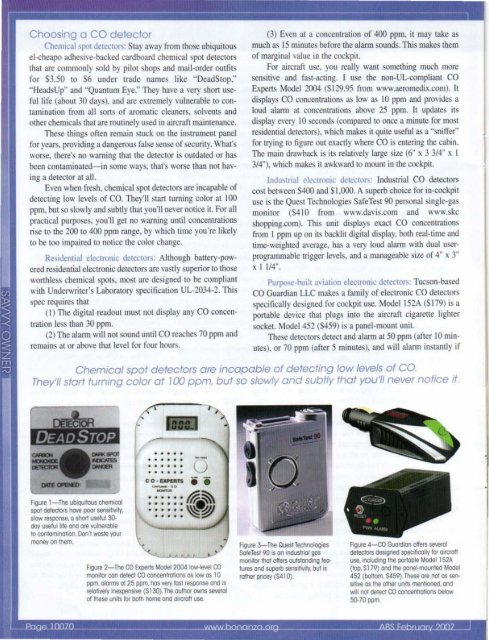February 2007 - American Bonanza Society
February 2007 - American Bonanza Society
February 2007 - American Bonanza Society
Create successful ePaper yourself
Turn your PDF publications into a flip-book with our unique Google optimized e-Paper software.
Choosing a CO detectorChemical spot detectors: Stay away from those ubiquitousel-cheapo adhesive-backed cardboard chemical spot detectorsthat are commonly sold by pilot shops and mail-order outfitsfor $3.50 to $6 under trade names like "DeadStop,""HeadsUp" and "Quantum Eye." They have a very short usefullife (about 30 days), and are extremely vulnerable to contaminationfrom all sons of aromatic cleaners, solvents andother chemicals that are routinely used in aircraft maintenance.These things often remain stuck on the instrument panelfor years, providing a dangerous false sense of security. What'sworse, there's no warning that the detector is outdated or hasbeen contaminated- in some ways, that's worse than not havinga detector at all.Even when fresh, chemical spot detectors are incapable ofdetecting low levels of CO. They'll start turning color at 100ppm, but so slowly and subtly that you'll never notice it. For allpractical purposes, you'll get no warning until concentrationsrise to the 200 to 400 ppm range, by which time you're likelyto be too impaired to notice the color change.Residential electronic detectors: Although battery-poweredresidential electronic detectors are vastly superior to thoseworthless chemical spots, most are designed to be compliantwith Underwriter's Laboratory specification UL-2034-2. Thisspec requires that(J ) The digital readout must not display any CO concentrationless than 30 ppm.(2) The alarm will not sound until CO reaches 70 ppm andremains at or above that level for four hours.(3) Even at a concentration of 400 ppm, it may take asmuch as 15 minutes before the alarm sounds. This makes themof marginal value in the cockpit.For aircraft use, you really want something much moresensitive and fast-acting. I use the non-UL-compliant COExperts Model 2004 ($ 129.95 from www.aeromedix.com). ltdisplays CO concentrations as low as 10 ppm and provides aloud alarm at concentrations above 25 ppm. It updates itsdisplay every 10 seconds (compared to once a minute for mostresidential detectors), which makes it quite useful as a "sniffer"for trying to figure out exactly where CO is entering the cabin.The main drawback is its relatively large size (6" x 3 3/4" x I3/4"), which makes it awkward to mount in the cockpit.Industrial electronic detectors: Industrial CO detectorscost between S400 and $1,000. A superb choice for in-cockpituse is the Quest Technologies SafeTest 90 personal single-gasmonitor ($410 from www.davis.com and www.skcshopping.com). This unit displays exact CO concentrationsfrom I ppm up on its backlit digital display, both real-time andtime-weighted average, has a very loud alarm with dual userprogrammabletrigger levels, and a manageable size of 4" x 3"x I 114".Purpose-built aviation electronic detectors: Tucson-basedCO Guardian LLC makes a family of electronic CO detectorsspecifically designed for cockpit use. Model 152A ($ 179) is aportable device that plugs into the aircraft cigarette lightersocket. Model 452 ($459) is a panel-mount unit.These detectors detect and alarm at 50 ppm (after 10 minutes),or 70 ppm (after 5 minutes), and will alarm instantly ifChemical spot detectors are incapable of detecting low levels of Co.They'll start turning color at 700 ppm, but so slowly and subtly that you'll never notice it .. . . . . . . . . . . ..... . uFigure l-The ubiquitous chemicalspot detectors have poor sensitivity,slow response, a short useful 3Ddayuseful life and Ofe vulnerable10 contamination. Don" waste yourmoney on them.Figure 2-The CO Experts Model 2004 low·level COmonitor can detect CO concentrations as low as 10ppm. alarms at 25 ppm. has very fast response and isrelatively inexpensive (S 130). The author owns severalof these units for both home and aircraft use.Figure 3-The Quest TechnologiesSafeTesl 90 is on industrial gasmonitor thol ofters outstanding featuresand superb sensitivity. but isrolher pricey (5410).Figure 4- CO Guardian offers severaldetectors designed specifically for aircraftuse, including Ihe portable Model 152A(lop, 5179) and Ihe panel·mounted Model452 (botlom, 5459). These ore nol as sen·sitive as the other units mentioned, andwill not detect CO concentrations betow50-70 ppm.

















